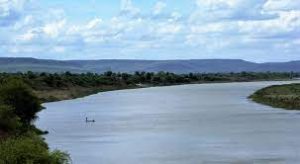Narmada River : New Guideline

A division bench of MP High Court recently granted time to the state government to present in the court the guidelines for urban and rural areas through which river Narmada flows in the state as regards construction in the vicinity of the river.
- Narmada River is the largest west-flowing river in peninsular India.
- The origin of the river is a tiny reservoir named Narmada Kund, which is situated on the Amarkantak Hill in the Anuppur District of East Madhya Pradesh at an elevation of 1,057 m (3,467.8 ft).
- The river flows through Madhya Pradesh, Maharashtra, and Gujarat between Vindhya and Satpura hill ranges before falling into the Gulf of Cambay in the Arabian Sea about 10 km north of Bharuch, Gujarat.
- The total length of the river from source to sea is 1312 kilometres (815 miles).
- It is one of the rivers that flow in a rift valley and acts as a divider between North India and South India.
- The river has numerous waterfalls, notably the Dhuandhar Falls, southwest of Jabalpur.
- The Narmada has several tributaries, with the most significant ones being the Tawa, Barna, Hiran, and Orsang rivers.




